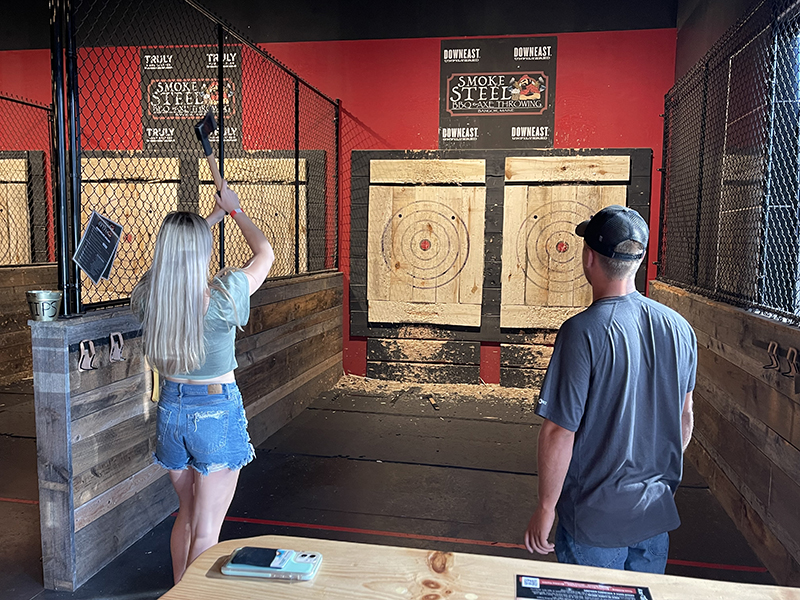The Fun of Axe Throwing: Just How This Sporting Activity Combines Ability and Adrenaline for a Great Time
Axe throwing has actually become a mesmerizing sporting activity that masterfully intertwines the demand for precise ability with the thrill of adrenaline, offering individuals a special and engaging experience. The act of tossing an axe in the direction of a target demands focus and strategy, at the same time cultivating an environment of sociability and friendly rivalry. This interesting mix of mental emphasis and physical exertion has actually made axe tossing a popular option for those seeking both leisure and a feeling of success. To really value the deepness and appeal of this activity, one should consider its origins, the necessary equipment, and the foundational techniques that ensure both security and enjoyment.
The Origins of Axe Throwing
Axe tossing, an entertainment activity that has actually gotten significant appeal in current years, traces its origins back to ancient times. The earliest records of axe usage in affordable contexts are discovered among the Celts and Vikings, that tossed axes for sport as well as in combat training.
Middle ages European warriors, especially during the Middle Ages, exercised axe throwing as component of their martial training. The Francisca, a sort of tossing axe utilized by the Franks, ended up being iconic for its deadly accuracy. This typical tool was designed to be tossed at opponent shields and shield, showcasing its twin utility in both sporting activity and battle.
In more recent background, axe throwing saw a revival in the logging camps of The United States and copyright in the 19th and 20th centuries. Lumberjacks would involve in friendly competition, checking their precision and stamina by aiming at wooden targets. This advancement from a survival skill to an entertainment activity has led the way for its modern renewal, with committed locations and leagues now commemorating the sporting activity worldwide.
Tools You Need
Recognizing the abundant history of axe tossing boosts the gratitude of the sport's contemporary version. For competitive and recreational axe throwing, the most generally utilized kind is the hatchet, usually evaluating between 1.25 to 2 pounds with a take care of length of around 16 inches.
Just as crucial is the target. Policy targets are constructed from wood, with softwood ranges like pine or cottonwood being favored for their capability to hold the axe and absorb. The target is normally divided right into five concentric circles, each with a specific factor worth, to facilitate rating.
Security equipment, however typically overlooked, is essential. Safety handwear covers can enhance grasp and stop blisters, while closed-toed shoes are a should to safeguard feet from gone down axes (denver axe throwing). A well-lit, spacious throwing area, full with security obstacles, makes certain a regulated atmosphere where participants can concentrate on honing their abilities.
Fundamental Techniques Discussed
Grasping the basic strategies of axe throwing is essential for both security and efficiency. The dominant hand ought to be placed directly below the axe head, while the non-dominant hand sustains the end of the deal with.
Following, concentrate on the stance. Stand with your feet shoulder-width apart, ensuring your body is stabilized. Your leading foot must be somewhat onward, straightening with your target. This positioning help in preserving stability and directing power accurately towards the target.

Safety And Security First
Making sure security in axe throwing is critical to producing a pleasurable and injury-free experience. A properly designed axe tossing facility features clear separations between tossing lanes, sturdy backgrounds to capture roaming axes, and non-slip floor covering to stop crashes.
Benefits of Axe Throwing
Axe throwing deals a myriad of advantages that extend beyond easy leisure. The recurring motion of tossing the axe also boosts hand-eye control and great motor skills.
Emotionally, axe tossing calls for precision, emphasis, and technique, making it an outstanding way to develop cognitive abilities. The focus required to hit the target can act as a type of mindfulness, permitting individuals to remove their minds and decrease stress. This psychological involvement can be specifically useful in helping people establish much better analytical abilities and psychological durability.
Socially, axe throwing is typically appreciated in team setups, promoting team-building and friendship. Whether as part of a company occasion or a laid-back outing with friends, the sporting activity motivates communication and collaboration. In addition, the communal experience of finding out and improving with each other can strengthen relationships and produce enduring memories.
Final Thought

The earliest documents of axe use in affordable contexts are found amongst the Celts and Vikings, that threw axes for sporting activity as well as in combat training. Release the axe when your hands are approximately at eye level, enabling the axe's natural rotation to guide it in the direction of the target.
A well-designed axe throwing facility functions clear demarcations between throwing lanes, durable backdrops to capture roaming axes, and non-slip floor covering to prevent crashes. Individuals have to be advised on the proper method to manage and toss the axe, emphasizing controlled, purposeful activities over forceful throws.
In recap, axe tossing stands out as a sport that masterfully incorporates ability, adrenaline, and accuracy.